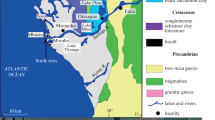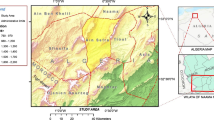Abstract
A total of 212 sand samples were collected from aeolian surface sediments in a major dune corridor, northwestern Kuwait. Five main physical properties were taken into consideration in analyzing aeolian samples, namely color, shape, roundness, particle morphometry, and surface area. The analysis of quartz particles by the scanning electron microscope shows the influence of transportation on the microfeatures of individual particles. The surface deposits are dominantly unimodal and occasionally bimodal. It is obvious that coarse and medium sand are the dominant size fractions within aeolian deposits. The results according to the Munsell color system between downwind and upwind values show no variations. Also, the average percentages of roundness subclasses for upwind and downwind samples are similar (6.7%). The average values (area, equivalent diameter, perimeter, and elongation) for aeolian samples in downwind are slightly higher than in upwind and Al-Dibdibba Formation samples, but the values overlap at 1 standard deviation. The interrelationship diagrams show that the shapes of the particles within samples in the three groups are running in the same trend. In general, the northwestern (upwind) particles show more mechanical and chemical features compared with southeastern particles (downwind). The slight variation between aeolian (upwind and downwind) samples is attributed to the transportation effect of these particles. This led to a conclusion, based on the overall results of physical properties, that the coarse and medium particles (about 80% of the whole aeolian sample) are dominantly derived from local sources.







Similar content being viewed by others
References
Al-Dousari AM, Pye K (2005) Mapping and monitoring of dunes in northwestern Kuwait. Kuwait J Sci Eng 32(2):119–134
Al-Dousari AM, Misak R, Ahmed M, Al-Mutairi M (2008) Characteristics of nabkhas in relation to dominant perennial plant species in Kuwait. Kuwait J Sci Eng 35:129–150
Al-Fredan MA (2008) Sand dune and sabkha vegetations of Eastern Saudi Arabia. Int J Bot 4(2):196–204
Al-Janabi KZ, Jawad Ali A, Al-Taie FH, Jack FJ (1988) Origin and nature of sand dunes in the alluvial plain of southern Iraq. J Arid Environ 14(1):27–34
Blott SJ, Pye K (2001) GRADISTAT: a grain size distribution and statistics package for the analysis of unconsolidated sediments. Earth Surf Proc Land 26(11):1237–1248
Bull PA (1981) Environmental reconstruction by scanning electron microscopy. Prog Phys Geog 5(3):368–397
Brunauer S, Emmett PH, Teller E (1938) Adsorption of gases in multimolecular layers. J Am Chem Soc 60:309–319
Culver SJ, Bull PA, Campbell S, Shakesby A, Whalley WB (1983) Environmental discrimination based on grains surface textures: a statistical investigation. Sedimentology 30:129–136
El-Sayed MI (2000) The nature and possible origin of mega-dunes in Liwa, Ar Rub’ Al Khali, UAE. Sed Geol 134(3–4):305–330
Embabi NS, Ashour MM (1993) Barchan dunes in Qatar. J Arid Environ 25(1):49–69
Goudie AS, Watson A (1981) The shape of desert sand dune grains. J Arid Environ 4:185–190
Guedes A, Ribeiro H, Valentim B, Noronha F (2009) Quantitative colour analysis of beach and dune sediments for forensic applications: a Portuguese example. Forensic Sci Int 190:42–51
Khalaf FI, Misak R, Al-Dousari AM (1995) Sedimentological and morphological characteristics of some nabkha deposits in the northern coastal plain of Kuwait, Arabia. J Arid Environ 29:267–292
Krinsley D, Doornkamp J (1973) Atlas of quartz sand surface textures. Cambridge University Press, Cambridge
Krinsley DH, Funnell BM (1965) Environmental history of quartz sand grains from the lower and middle Pleistocene of Norfolk, England. Q J Geol Soc Lond 121:435–461
Kuenen P (1960) Experimental abrasion-eolian action. J Geol 68:427–449
Lancaster N (1995) Geomorphology of desert dunes. Routledge, London
Pease PP, Bierly GD, Tchakerian VP, Tindale NW (1999) Mineralogical characterization and transport pathways of dune sand using Landsat TM data, Wahiba Sand Sea, Sultanate of Oman. Geomorphology 29(3–4):235–249
Pell S, Chivas A, Williams I (2000) The Simpson, Strzelecki and Tirari Desert: development and sand provenance. Sed Geol 130:107–130
Pye K, Tsoar H (1990) Aeolian sand and sand dunes. Unwin Hyman, London, p 396
Saqqa W, Attallah M (2004) Characterization of the aeolian terrain facies in Wadi Araba Desert, southwestern Jordan. Geomorphology 62:63–87
Walden J, White K, Drake N (1996) Controls on dune colour in the Namib sand sea: preliminary results. J Afr Earth Sci 22(3):349–353
Wasson RJ (1983) Dune sediment types, and colour, sediment provenance and hydrology in the Strzelecki-Simpson dunefield, Australia. In: Brookfield, Ahlbrandt (eds) Developments and sedimentology, 38th edn. Elsevier, Oxford, pp 165–195
Wells NA (2002) Quantitative evaluation of color measurements: I. Triaxial stereoscopic scatter plots. Sed Geol 151:1–15
White K, Bullard J (2009) Abrasion control on dune colour: Muleshoe Dunes, SW USA. Geomorphology 105:59–66
Acknowledgments
This work was funded by two foundations. These are Kuwait Foundation for the Advancement of Science (KFAS) for project (2008-1505-03) and the Kuwait Institute for Scientific Research (KISR) for (ECO77C). Thanks also to Mr. I. Ibrahim for helping in drafting some of the figures.
Author information
Authors and Affiliations
Corresponding author
Rights and permissions
About this article
Cite this article
Al-Dousari, A.M., Al-Hazza, A. Physical properties of aeolian sediments within major dune corridor in Kuwait. Arab J Geosci 6, 519–527 (2013). https://doi.org/10.1007/s12517-011-0353-0
Received:
Accepted:
Published:
Issue Date:
DOI: https://doi.org/10.1007/s12517-011-0353-0




